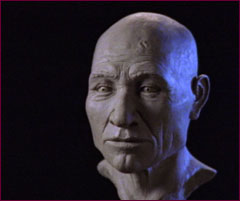
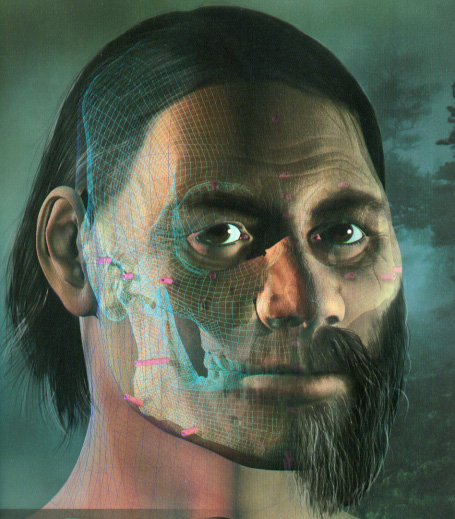


Will the real Kennewick Man please stand up?
Introduction to Archaeology and Palaeoanthropology:
Humanity's Journeys
Dr. Kathryn Denning Anth 2140, Sept 2005 - Apr 2006
21 Mar 2006
Plan for the day
1 Course business/ announcements...
2 Quiz
3 Archaeology, ethics, politics
Reading and Assignments
Today's readings (Mar 21)
Course Kit: Action Archaeology and the Community at El Pilar, Cultural Resource Management
AND these online readings.
Issue: Ethics and archaeology.
Can you dig it? http://www.economist.com/science/displayStory.cfm?story_id=1056932
Issue: Repatriation
Read the Kennewick Man Virtual Exhibit at the Burke Museum: www.washington.edu/burkemuseum/kman/virtualexhibit_intro.htm Ensure that you see the pages called Chronology of Events Who are Native Americans? Ancient People in the Americas The Idea of Race Native American Views Anthropologist's Views
Issue: Looting in North America
Hester Davis 1998. Facing the Crisis. Archaeology Magazine. http://www.archaeology.org/online/features/loot/index.html Read each section.
Issue: History that hurts
Alyssa Fisher. 2003. A Sight Which Can Never Be Forgotten. Archaeology Magazine. http://www.archaeology.org/online/features/massacre/index.html
Issue: Archaeology and War
Spoils of War, re: Iraq, from 2003. http://www.archaeology.org/0307/etc/war.html
(Optional: for more, see Protecting Iraq's Ancient Heritage: http://www.archaeology.org/online/features/iraq/index.html )
Special note! Come to tutorial on March 22nd, prepared to discuss and
debate the subject of archaeology, human remains, and repatriation.
Next week's readings (Mar 28):
Course Kit: Legacies of Human Evolutionary History
and
The Ends of the World as We Know Them www.truthout.org/docs_05/010205Y.shtml
Godzilla's Attacking Babylon: http://www.archaeology.org/online/features/godzilla/
Archaeology and the Contemporary World: history, ethics, politics.
The subjects of conquest and present-day issues in archaeology / politics / ethics are related.
Recall:
- that the destruction of history (whether written or material) has often been used by rulers to attempt to instigate a new order: e.g. destruction of records in China, Mexico (by the Aztec and later by the Spanish); renaming of places (e.g. place names in Ontario); destruction of monuments, sacred places, towns, cities
- that retelling history to one's own advantage is a powerful way to claim rightful ownership of land (e.g.s Moundbuilder Myths, Nazi archaeology)
- that archaeology began in Egypt as part of the colonization attempts of France and Britain
- that anthropology and archaeology began in North America during the process of colonization... partly to document the 'exotic', partly because it was believed that Native people would soon be completely extinct... which, of course, they are not. (Myth of the "Vanishing Indian")
- SO.... archaeology is deeply political.... because it reconstructs histories in a certain way and dismissed other histories, because it objectifies people, because it has had a certain way of treating material objects (which tends to get translated into 'treasure', which gives them a monetary value), and because it has a certain way of treating human remains... i.e. people as specimens. This has led to problems.
- it continues to be related to colonization because of 'who archaeologizes whom'.
Challenges for Archaeological Heritage in the Present Day:
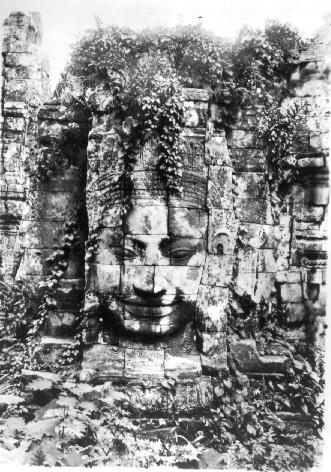
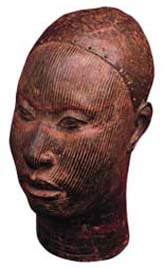
Consumption - from "mummy" to the manufacture of fakes, to looting (e.g. Slack Farm), to the antiquities market (Red List)... eBay.... n.b. looting isn't just a small-scale problem.... involves major museums too. Looting is worsened in wartime, e.g. Iraq
Destruction - sometimes religiously or politically motivated. Sometimes in war, sometimes not. e.g.s Bamiyan Buddhas, Babri Masjid in Ayodhya, Bosnia, ... Iraq too
Eradication - economically motivated, e.g. megadam projects like Three Gorges (China), or Ilisu (Turkey)
Protection - e.g. efforts via World Heritage and other international legal instruments... idea that heritage belongs to us all (we all have the responsibility to care for it, and all have the right to enjoy it)
Commercialisation - e.g. tourism, e.g. native burial grounds, Angkor Wat, Machu Picchu
Celebration - the bright side! e.g. equinox or solstice ceremonies at Stonehenge and also at Teotihuacan
Key questions about who should control the past:
- is the past a resource? if so, who should get to use it? who should have the responsibility of guarding it? who should get to profit from it?
- to what extent should we try to make amends for wrongs in the past?
- rights -- e.g. weighing individual vs. collective rights, rights of interested individuals (interested for whatever reason) vs. rights of descendant communities, vs. rights of science, rights of the public
Repatriation
The Vermillion Accord, 1989, World Archaeological Congress http://www.wac.uct.ac.za/archive/content/vermillion.accord.html
1.Respect for the mortal remains of the dead
shall be accorded to all, irrespective of origin, race, religion, nationality,
custom and tradition.
2.Respect for the wishes of the dead concerning disposition shall be accorded
whenever possible, reasonable and lawful, when they are known or can be
reasonably inferred.
3.Respect for the wishes of the local community and of relatives or guardians of
the dead shall be accorded whenever possible, reasonable and lawful.
4.Respect for the scientific research value of skeletal, mummified and other
human remains (including fossil hominids) shall be accorded when such value is
demonstrated to exist.
5.Agreement on the disposition of fossil, skeletal, mummified and other remains
shall be reached by negotiation on the basis of mutual respect for the
legitimate concerns of communities for the proper disposition of their
ancestors, as well as the
legitimate concerns of science and education.
6.The express recognition that the concerns of various ethnic groups, as well as
those of science are legitimate and to be respected, will permit acceptable
agreements to be reached and honoured.
From this document came others like NAGPRA.
Biologically Dead, Socially Alive:
'Kennewick Man'


Video segments:
Mystery of the First Americans (York vid #6071
Who Owns the Past? (York vid #0209)
SOME ISSUES regarding the Kennewick Case
Naming - what do we call him? (Why should he be known by "Kennewick Man" rather than by the Native name for him?
Who were the parties involved in the Kennewick case?
Archaeologists for study without permission - in the minority.
Archaeologists for collaboration
Archaeologists for repatriation
Other scientists
Umatilla confederacy - asking for straight repatriation (but within
that confederacy of five groups - there will be differences of opinion)
Native people who would like it to be studied
Museum personnel
Army
Multiple levels of government - federal, state, municipal
Media - multiple levels
Asatru Folk Assembly - another religious community; but brings up the
religious affiliation question ('Original Viking Settlers of North America")
Polynesian man also launched claim.
WEIGHING RIGHTS
- rights of the individual vs. the collective, and the rights of the minority vs. the majority, and the rights of specific groups over the general collective (arch as a universal human resource)
- rights are ascribed and vary from culture to culture and time to time. Intractable question - how do you determine affiliation without study? But how do you study if it's sacrilege? Reconstruction
Below: From Skull Wars, David Hurst Thomas
Chatters' reconstruction... looks European... like Jean-Luc Picard
Above: Or does Kennewick Man look more like Chief Black Hawk, as Deloria suggest?
Or should Kennewick Man be reconstructed with Ainu features?
From National Geographic, December 2000.

Who are the Ainu?
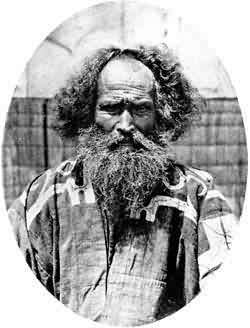
Ainu, indigenous people of Northern Japan - language isolate, earlier population, traditional lifestyle was hunting/fishing/gathering. DNA shows may be descendants of ancient Jomon population (13 000 BC to 300 BC).
Became minorities after invasion of people now known as
ethnic Japanese,
especially from the 1400s onward. Like Native people in North America, the Ainu
are having to work hard to maintain
cultural rights and also to get skeletons repatriated from Japanese universities
Latest reconstruction, last week, TIME magazine: making him look younger, in response to a suggested new age estimate
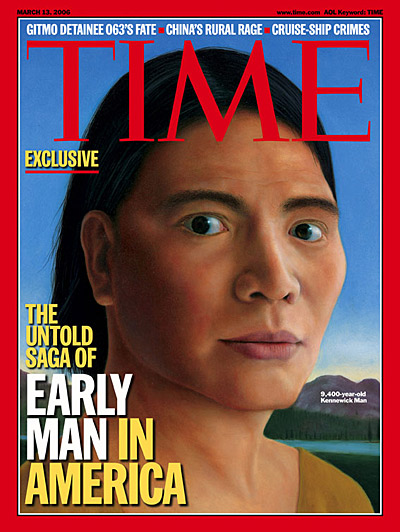
Moral of the story with reconstructions:
- they are subjective
- they are easily manipulated by the media and others
- they are of little scientific value
- there is no neutral way to do them (pale clay with no hair does not 'read' as
ethnically neutral!)
- they can be adjusted to fit different scientific theories
The matter of skull shape and what it means.
- very little!
- it can be used to learn about populations but
this is tremendously difficult when we're looking at it over long periods of
time.- we would not expect any ancient population to look exactly like
its descendants
- skull shape is determined not only by genetics but also by environment during
the lifetime
Historical notes
- recall the work of Samuel Morton, who was
focusing on cranial capacity as a measure of intelligence and managed to 'prove'
racial differences in brain size etc.... but who was very much mistaken (see
Stephen Jay Gould, Mismeasure of Man)
- ultimately this was disproven by later anthropologists, and also the subject of skull shape was shown to be complicated and not a simple racial indicator or indicator of intelligence.
- but it's a terrible irony that as part of the endeavour to learn more about skulls, early anthropologists (like Boas) in the 1800s and early 1900s were part of skull collecting expeditions that are absolutely horrifying by modern standards -- taking heads and bodies from very recent Native burials as though it was simply essential scientific work
(bear in mind though that digging up recent graveyards of poor people of all ethnicities was standard practice for medical students in the 1700s and into the 1800s too)
Bottom Line with the Kennewick Case
- it's tremendously compounded by politics, by long-term conflicts between groups, by long-term oppression of Native peoples, by racism (e.g. white supremacists)
- it's made difficult by the legal implications with respect to land claims; in some places, demonstrating long-term occupation of an area has consequences for present-day people
- and it's made difficult by the fact that some people appear not to understand that studying skulls is not a neutral activity that everyone supports! What should be the default option?
Scientific study isn't a neutral default.
Museum isn't a neutral default.
(Is
there any neutral use of the past?) Archaeology isn't
neutral either. (what agendas does archaeology serve? what lenses does it see
through? what historical baggage does it carry?)
- it's made difficult by lack of historical
cooperation. c.f.
Kwaday dan Sinchi case, in BC, in which there was
a good precedent for conversation and cooperation. There are other similar
cases, too, where parties have been able to compromise.
- it's made difficult by the fact that
scientists/ archaeologists lose control over media understandings
- we must always consider what knowledge is worth in terms of human suffering (Just how much can you learn from one set of ancient human remains? Sex, age, etc…. injuries, diet, lifeway…. biological population affiliation - WHAT IS THAT KNOWLEDGE WORTH?)
- we must always realize that there is a
divide between subject and object -- what does it do to make people into
objects?
- Heritage of all humanity? Kennewick belongs to all of us? Chatters' opinion, and e.g. opinion here: http://seattletimes.nwsource.com/html/editorialsopinion/2001852530_maned07.html
- This brings us to the subject of "who has the right to use heritage?" and "who does heritage belong to?"
So what do YOU think?
There are still well over 100 000 sets of human remains, mostly Native, in North American museums.
What should be done with them?
Who should have been given custody of "Kennewick Man"?
Under what circumstances should scientists be allowed to study human remains?
Why?
Archaeology as a way of restoring history... archaeology of slavery and the case of the African Burial Ground in New York
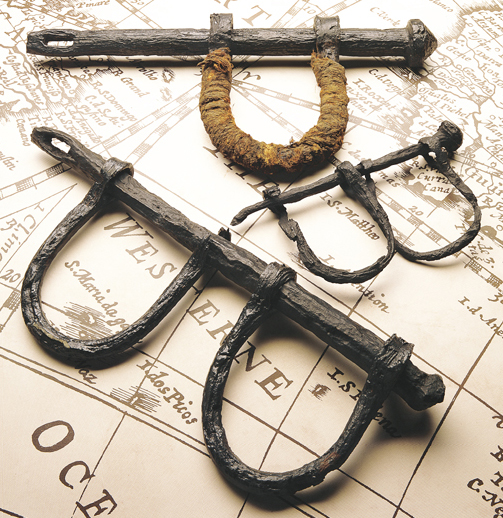
shackles from the slave ship Henrietta Marie
Interesting Reading:
Stealing History: www.mcdonald.cam.ac.uk/IARC/Display/Interactive.htm
Repatriation from the Smithsonian Institution www.nmnh.si.edu/anthro/repatriation/page1.htm
E.g. Ontario: http://collections.ic.gc.ca/heirloom_series/volume3/chapter2/part2.htm
LOOTING: http://www.mc.maricopa.edu/dept/d10/asb/anthro2003/archy/pothunting/
Little Big Horn: http://www.custerbattle.com/
Archaeology of Slavery: The African Burial Ground in New York
The New York African Burial Ground Project:
An Examination of Enslaved Lives, A Construction of Ancestral Ties
www.huarchivesnet.howard.edu/0008huarnet/blakey1.htm
Return to the African Burial Ground:
www.archaeology.org/magazine.php?page=online/features/blakey/index
Under City Hall Park: www.archaeology.org/found.php?page=/online/features/cityhall/index.html
www.cnn.com/TECH/9802/12/t_t/burial.ground/
www.africanburialground.com/ see Press section and view a selection of articles.